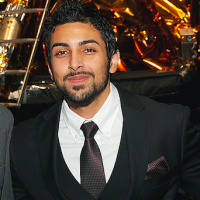Two sides of the same coin: NASA Postdoctoral Fellow Ali Hyder discusses the duality of his work

Science is also art because you have to be creative in a specific way, Hyder says in this interview for Further Together: The ORAU Podcast. Hyder takes a deep dive into why modeling Jupiter's hydrodynamics is important for better understanding Earth, as well as how he became interested in science and the NASA Postdoctoral Fellowship Program.
Transcript for the episode (.DOCX)
Center: Jet Propulsion Laboratory
Ali Hyder, Ph.D., describes his work modeling the surfaceless planet Jupiter as both a blessing and a curse.
Hyder loves the work itself, and feels he has been called to science ever since he was a child. However, the very thing that makes Jupiter an important planet to study is what makes it so difficult to model.
“A lot of my work has been in atmospheric fluid dynamics—what we call hydrodynamics—so I do theory and modeling and primarily apply all that to the atmosphere of Jupiter, the biggest planet in the solar system,” he said in a recent interview for Further Together, the ORAU Podcast. “As such, I work fairly closely with the Juno Mission. Most of my science is done in support of that mission or supplementing that data using my models and bringing experiments and theory together.”
Jupiter is a gas giant, and as Hyder explained, gas giants create an opportunity to study fluid dynamics that don’t exist on Earth. However, by studying these distant planets, Hyder and the rest of the researchers at NASA are learning more about Earth.
“Jupiter has no surface, so the atmospheric fluid dynamics actually occur in their most uninhibited form, in a sense,” explained Hyder. “It gives you a significant insight into what the physics of those processes are and allows us to dive deeper into a more generalized theory of planetary climatology, and that will certainly in the future be providing more information about the climate of Earth, as well.”
But the lack of a surface on Jupiter is what makes the work itself difficult—because such an environment doesn’t exist on Earth, the planet can’t be completely modeled in the lab.
“We don't actually even know if Jupiter has something akin to a core,” said Hyder. “We know it has an over density, kind of like a fuzzy core, but it's a complicated thing, because oftentimes, you have to assume a lot of things about the interior model and then work backwards. It’s a blessing and a curse because of course, when you have a boundary condition, although you know that the atmosphere is limited, you get hit with computational issues.”
Hyder was raised in a family of artists and is a musician himself. Hyder posits that the creativity which birthed his curiosity is what makes him a great scientist.
“Now that I have become a professional scientist, it's cool to see my own trajectory in that light, and how we evolve in our creative thinking. And science is also, I would argue, an art because you have to be creative in a very specific sort of way,” he said. “It’s just the other side of the coin.”
Hyder explained that being naturally inquisitive is also a helpful trait at NASA’s Jet Propulsion Laboratory, where he conducts his research. Not only does curiosity lend itself to better science, but it also fosters a collaborative environment among the other scientists.
“The collaborative ethos here is really interesting, because you go to the cafeteria and you'll just run into somebody that's working on something kind of adjacent, but approaching it from a completely different perspective, and you end up having coffee with them and a paper comes out of it,” he said. “It's a unique place to be from that perspective. That’s also a testament to the type of talent that's available here and at NASA centers in general, where people are performing at the frontier of science.”
Hyder’s NASA Postdoctoral Fellowship only began recently, and he completed his doctoral degree in the summer of 2024. He is only at the beginning of his postdoctoral career, but it’s safe to say that he will allow his curiosity and creativity to carry him to new heights.
